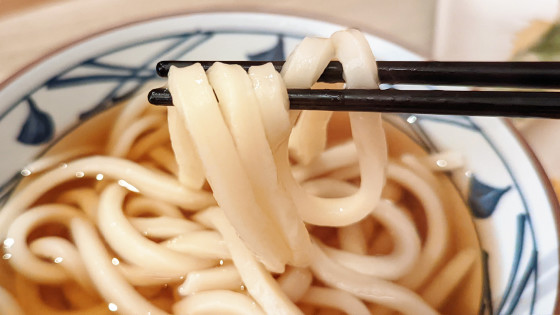Finally, Marugame Noodles, which entered the UK, has eaten a local limited menu 'Udon for vegans' with zero animal ingredients

Marugame Seimen, a Sanuki udon specialty store, has stores outside of Japan. Its popularity surpasses that of Japan, and
Marugame Udon - Authentic Japanese Udon Restaurant
https://marugame.co.uk/
At the time of writing the article, Marugame Seimen has 5 stores in London, and this time I went to St Christopher's Place store . The address is 14-15 Barrett St, London W1U 1LX .
The closest station to St Christopher's Place is Bond Street Station on the London Underground. Below is the exit facing Oxford Street.

The entrance of St Christopher's Place is on the north side about 20m west of the station. At first glance it can only be seen as a gap between buildings ... ...

It has a sign that says 'St Christopher's Place' so you can walk through it. The entrance is quite narrow and thin, so much so that if you don't know it, you'll pass by.

You can see what the road looks like from near Bond Street Station through St Christopher's Place, where Marugame noodle shops are located, by watching the following movie.
After walking about 40 meters on the cobblestone road, you will come to St Christopher's Place, and Marugame Seimen is on the far right.

There was a signboard at the store that said 'Noodles. Dashi. Tempura. Love'.

Tables and desks are lined up like a cafe terrace in front of the store, and it seems that udon can be eaten outside.

A digital signage displaying the menu was visible through the glass facing the outside of the store. In addition to familiar menus in Japan such as ``Kamaage'', ``Kake'' and ``BK (bukkake)'', there were also regular menus of overseas stores such as ``Two Pork Tonkotsu'' and ``Chicken Katsu Curry''.

When I entered the store, the words 'welcome to our kitchen' caught my eye.

Marugame Umbrellas were sold next to the entrance.

The method of ordering udon is the same as in Japan, where you take a tray and go to the counter and tell the staff what kind of udon you want to eat.

The store clerk was boiling udon on the other side of the glass just after getting off the steps in the store.

It is said that the wheat flour used is from Japan. It seems that the noodles are made in the store, and I could see the clerk putting the noodle dough into the noodle making machine.

A pot in which a large amount of udon is being boiled

The cooking equipment and the udon noodles that are divided into individual balls are common sights at Marugame Seimen in Japan.

Pour the dashi stock into the bowl containing the boiled udon noodles. This time I ordered Kake Udon for vegans. The price is 4.75 pounds (about 770 yen).

Some of the tempura is basically the same as in Japan, but there are also some items that you don't often see in Japan.

Pay the price and hang around to find a place to eat in the store. This time I decided to sit at the counter seat and eat.

The seasonings on the table were soy sauce, sesame oil, and chili oil. Soy sauce is also placed in Marugame Noodles in Japan, but sesame oil and chili oil may be rare.

So, I ordered zucchini tempura (1.45 pounds, about 235 yen) and asparagus tempura (1.25 pounds, about 200 yen) for vegan kake udon.

Kake udon has neither ingredients nor green onions. The appearance is completely the same as eating udon in Japan. However, the scent is quite different. According to the

The first thing I noticed when I tried it was that it had a different texture than the udon you get at Marugame Seimen in Japan. Udon itself has nothing to do with the vegan menu, so I thought it would be the same as in Japan before eating it. Marugame Seimen's udon is softer and has a chewy texture rather than elasticity. In addition, the dashi does not have any of the fish stock's peculiar flavors, and the umami is not as strong as in Japanese dashi, but the sweetness derived from vegetables is stronger than the saltiness, resulting in a gentle taste.

The zucchini tempura, which I have never seen in Japan, had a fluffy texture, and I felt that it went well with the gentle sweetness of the udon soup stock.

Before I ate the asparagus tempura, I thought, 'Is it like burdock tempura?' It was fried softly while leaving.

Related Posts:







